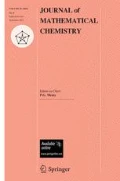Abstract
Nanojoins are parts of large carbon molecules joining several nanotubes with the same or different parameters and chemical and electrical properties. It is known that Euler’s formula implies that such nanojoins must contain faces that are not hexagons if at least three tubes are joined. As the atoms in a nanojoin are carbon atoms preferring hexagonal rings, it is normally assumed that apart from hexagons only pentagons and heptagons occur. In this paper we will give necessary and sufficient conditions for the existence of nanojoins joining nanotubes with given parameters and given numbers of pentagons and heptagons.








Similar content being viewed by others
References
L. Balke, Classification of disordered tilings. Ann. Comb. 1(4), 297–311 (1997)
G. Brinkmann, Zur mathematischen Behandlung gestörter periodischer Pflasterungen. Ph.D. thesis (Bielefeld, 1990)
G. Brinkmann, A.W.M. Dress, A constructive enumeration of fullerenes. J. Algorithms 23, 345–358 (1997)
G. Brinkmann, U.V. Nathusius, A.H.R. Palser, A constructive enumeration of nanotube caps. Discrete Appl. Math. 116(1–2), 55–71 (2002)
G. Brinkmann, N. Van Cleemput, Classification and generation of nanocones. Discrete Appl. Math. 159(15), 1528–1539 (2011)
A.W.M. Dress, On the classification of local disorder in globally regular spatial patterns, in Temporal Order (Bremen, 1984), Volume 29 of Springer Ser, Synergetics (Springer, Berlin, 1985), pp. 61–66
M.S. Dresselhaus, Down the straight and narrow. Nature 358, 195–196 (1992)
M.S. Dresselhaus, G. Dresselhaus, P. Avouris, Carbon Nanotubes: Synthesis, Structure, Properties, and Applications. Physics and astronomy online library (Springer, Berlin, 2001)
M. Ficon, Die \((s,t)\) Klassifikation von Halftubes. Master’s thesis (Universität Bielefeld, 2004)
S. Guo, The creation of nanojunctions. Nanoscale 2(12), 2521–2529 (2010)
P.X. Hou, C. Liu, H.M. Cheng, Purification of carbon nanotubes. Carbon 46(15), 2003–2025 (2008)
S. Iijima, Helical microtubules of graphitic carbon. Nature 354, 56–58 (1991)
S. Iijima, T. Ichihashi, Y. Ando, Pentagons, heptagons and negative curvature in graphite microtubule growth. Nature 356, 776–778 (1992)
S.J. Tans, M.H. Devoret, H. Dai, A. Thess, R.E. Smalley, L.J. Geerligs, C. Dekker, Individual single-wall carbon nanotubes as quantum wires. Nature 386, 474–477 (1997)
Author information
Authors and Affiliations
Corresponding author
Rights and permissions
About this article
Cite this article
Brinkmann, G., Mourisse, D. & Rylands, L. On the existence of nanojoins with given parameters. J Math Chem 53, 2078–2094 (2015). https://doi.org/10.1007/s10910-015-0535-1
Received:
Accepted:
Published:
Issue Date:
DOI: https://doi.org/10.1007/s10910-015-0535-1




